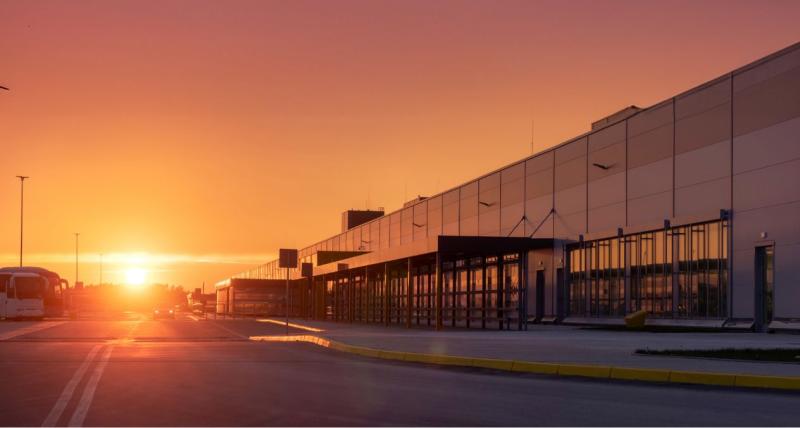As the third-largest U.S. industrial real estate operating platform, Ares believes that we are entering the most compelling entry point into the industrial real estate sector since the GFC (Great Financial Crisis).
To better understand what is going on within the sector, Ares’ Financial Advisor Solutions Team sat down with the Head of Ares Industrial Management, Dave Fazekas, who oversees a team of 170 professionals focused on sourcing, acquiring, developing and managing industrial real estate properties across the U.S. Dave has more than 26 years of experience and has helped build Ares’ $22.5 billion1 industrial real estate group into the dynamic platform it is today.
Q&A with Head of Ares Industrial Management
Q: Dave, what is your view on the macro environment for industrial real estate right now?
I think the place to start is by emphasizing, maybe against expectations, what a resilient year it was in 2023. There was a widespread expectation based on interest rate hikes that we were heading for a recessionary environment of low growth.
In actuality, GDP and the overall economy continue to exceed expectations. The biggest contributor to this has been household consumption, driven by a strong labor market and continued wage growth, which is filtering through the sector.
We are now seeing signs of a bottom in transaction pricing forming and a resurgence in transaction volume first-hand, with activity levels more in line with the levels we saw in late 2021. Compelling opportunities have started coming to market— primarily from large ODCE2 funds that are facing redemption queues (with problems stemming largely from heavy office exposure) and have a need for liquidity. We are also in the market with several small portfolios to tactically sell, with a deep pool of high-quality bidders above expected pricing.
Core industrial cap rates3
Against the current backdrop of interest rates stabilizing in a narrow band, spreads on industrial debt tightening, new allocations of capital for lenders and fundamentals remaining resilient, we believe buyers are gaining confidence to lean in on new opportunities, which is creating a floor in pricing. Given the real progress made in reducing inflation over the past 12 months, there is much more confidence that rates have peaked, and directionally they will start to come down, albeit more slowly than anticipated. The cost of capital for real estate, particularly industrial real estate, is moderating.
Q: Why do you have so much conviction in the sector long-term?
When you think about the long-term secular tailwinds—the penetration in the e-commerce space still being relatively small and back on trend after an overshoot during COVID, the acceleration of onshoring/nearshoring, and the ecosystem of supplier networks building around that—we are very bullish on the sector over the long term.
Projections for e-commerce are that over the next five years, there will be another $400 billion of incremental online sales, which, in turn, will drive a need for industrial warehouse space. By way of example, Amazon has taken 11 million square feet of space in Q1 2024 alone—that’s three million more square feet than in all of 2023 combined.4
We are seeing more space being leased to customers that are reshoring their manufacturing. When you think about two wars, geopolitical risks, disruptions to Red Sea shipping lanes and drought that’s making it hard for larger ships to pass through the Panama Canal, there’s an urgency for users to create a broader, more stable supply chain and to make a shift from just-in-time to just-in-case inventories. This has become a major post-COVID priority of the C-suite and is already being implemented, helped along by the Inflation Reduction and Chips Act and the Infrastructure & Jobs Act, with their focus on chips, medical devices, green energy initiatives and biomanufacturing. Twenty percent of Asia-sourced freight is forecasted to move onshore by 2025, increasing to 40% by 2030.5 The supply chain issues are really driving this move to onshore and nearshore manufacturing in North America, and that all means more demand for warehouse space.
Q: Can you help us better understand the supply-and-demand dynamics at play?
Industrial real estate vacancy is approximately 6.2%, still far below the historical (20+ year) average of 7.1%.6
Since 2015, up until Q2 2022, the new supply or new construction starts for industrial had increased to meet the incremental 30% demand from e-commerce over that time. What happened during COVID was that we had some delays in construction and completions. Some of that got pushed out into what you see below in 2022. And then, in Q2 2022, we peaked out from a new-starts perspective—and in the industrial space, it can typically take only 12–18 months to build these properties.
Conversely, due in part to liquidity constraints for developers and lenders and the higher cost of debt, construction starts are down 77% year-over-year,6 which is anticipated to create another period of undersupply as we look forward to 2025 and beyond. In Q1 2024, there was less than 40 million square feet of new construction starts, numbers we have not seen since 2012.
U.S. logistics supply growth falling below pre-pandemic averages7
We believe that is really setting the U.S. industrial market up for success, as limited new construction will deliver after Q2 2024, potentially further driving an increase in rental rate growth in 2025 and beyond after absorbing the product in the near term.
Q: Is the market presenting any occasions to be opportunistic?
We are seeing discounts of 15–25% in certain assets, for various reasons. The life of a fund may be ending, a manager may be facing redemptions in an open-end vehicle, or a loan may be expiring that can’t be refinanced, resulting in a need to generate liquidity to pay back that loan or fund redemptions. That’s what really has led to the increase in transaction volumes in early 2024. And that is really where we’re seeing repriced assets come to market and where managers with dry powder can capitalize.
Q: Since you mention loan expirations…after a strong 2021 and 2022, commercial lending activity drastically declined in 2023, with new bank credit down about 83%. What do you think about private real estate lending?
What’s interesting is that you have high nominal yields and spreads that are historically high relative to what they’ve been. So in today’s environment, we can get equity-like returns by investing in real estate debt.
Private lenders can generally set a spread that’s wider today, at about 3–4% on average. When you layer in origination fees, that brings your potential total unlevered return on a new piece of debt to more like the 9.5% range—at a lower loan-to-value, and with lender-favorable covenants.
Q: Thanks so much, Dave—how would you wrap it all up?
When you take a step back and think about the reset of values that we’ve seen, real progress on inflation relative to 2023, interest rates peaking and construction starts off 77%, and you combine that with the resilient demand we’re seeing in our own portfolio, we believe this is setting up to be the best entry point into the industrial space that we’ve seen since the GFC. I couldn’t be more optimistic about the opportunity set in front of us.







